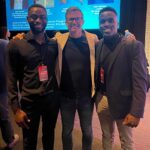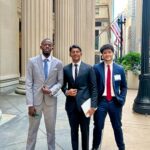
Physics Students Design and Construct a Novel Type of Wind-Powered Mechanical Clock
WOOSTER, Ohio – Two Independent Study’s (I.S.), one National Science Foundation grant, and five years of intermittent research by College of Wooster students under the guidance of John Linder, chair of the department of physics, have resulted in the design and construction of an innovative wind-powered mechanical clock. It utilizes 3D-printed bistable elements that interact with the wind to couple them one-way, producing a perpetual transverse motion. The research was recently published in Chaos, an interdisciplinary journal of nonlinear science.
“Momentum conservation, or Newton’s third law, ensures two-way or bidirectional coupling for typical media like guitar strings and spring mattresses. One-way, or unidirectional, coupling enables the propagation of solitary waves, or solitons, with diverse behaviors in otherwise dissipative media, but at the expense of both momentum and energy conservation,” Lindner explained. “Nevertheless, one-way media are possible, provided the coupling is powered to conserve overall momentum and energy.”
Funded by a grant from the NSF, this original concept extracts energy and momentum from moving air to generate solitary waves continuously with no intrinsic power source. “Wind forces (the) elements into a spatially alternating configuration … thereby compelling indefinite one-way motion. (It) demonstrates the creation, propagation, and annihilation of solitons,” according to Lindner.
The final product represents five years of recurrent work, which Lindner began with Katsuo Maxted ’12, whose I.S. was “Cyclic Aero-Mechanical Array of One-Way Coupled Oscillators.” The idea steadily evolved, with elements becoming smaller among other updates, thanks in part to summer research by Prakrit Shrestha ’14 and Matt King-Smith ’16.
And in 2015-16, Graham Schattgen ‘16 improved it further with his I.S., “Air Powered One-Way Arrays.” His final array included decreasing the size of the elements further and reducing the number of the 3D printing spacers, which led to observations of spontaneous soliton-antisolitan creation.
Lindner, Maxted, Shrestha, King-Smith, and Schattgen were all co-authors of the Chaos article, as was Tessa Rosenberger, a current undergraduate student at the University of Dallas who perfected the apparatus last year in Wooster’s NSF-funded summer research program.
Posted in News on March 22, 2017.
Related Posts
Related Areas of Study
Physics
With one-on-one guidance from a faculty mentor, every physics major completes independent research in a year-long research project
Major Minor

